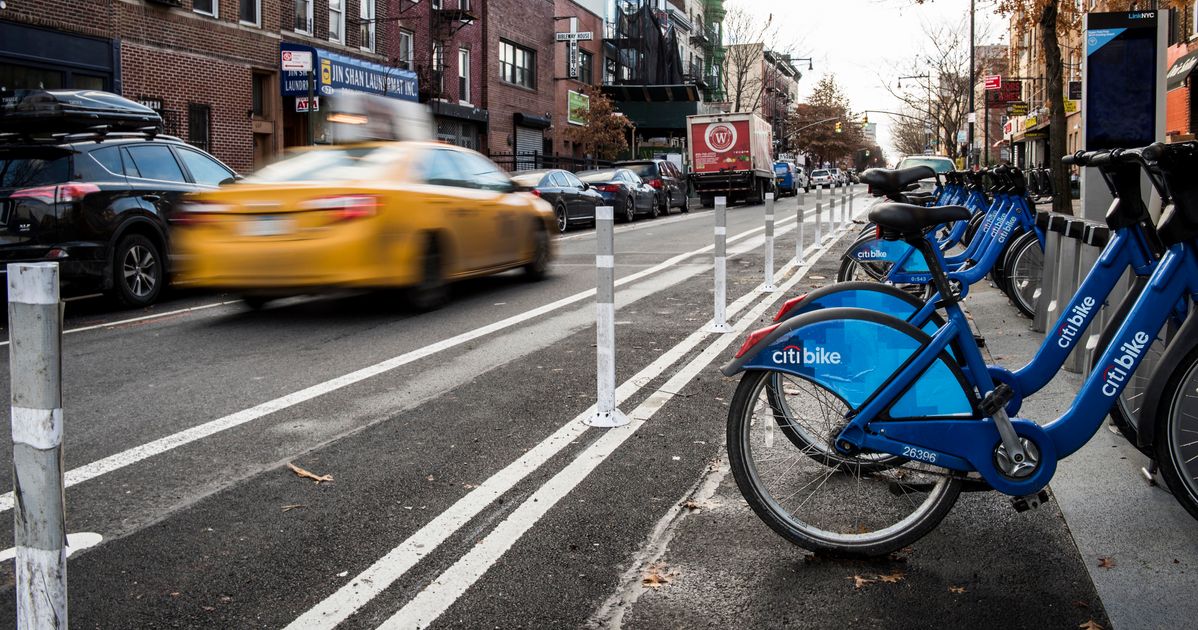To the residents at 1030 Carroll Street in the Crown Heights neighborhood of Brooklyn, a new bank of Citi Bikes ― the bike sharing program typically found in wealthier neighborhoods ― isn’t a sign that city officials are investing in their health and wellness. Instead, it’s a signal to longtime residents that their area has entered late-stage gentrification.
“As people move out, new people move in and their rents are going sky high,” said Clentine Fenner, 68, who has lived at 1030 Carroll Street since 1976.
Fenner, a retired educator and childcare advocate, has spent the bulk of her adult life in her first floor apartment.
Over the past century, Crown Heights has been a neighborhood that includes communities of Hasidic Jews, African-Americans who migrated from the South and Caribbean immigrants. In the early 2000s, affluent white residents started moving in from Manhattan, attracted by historic brownstones, easy access to the borough’s cultural institutions and subway, and close proximity to the 526-acre Prospect Park.
Fenner appreciates some of the perks that investment in Crown Heights has accrued, like new cafes and restaurants, and trees that the city planted on her block. She’s less enthusiastic about her building’s ongoing construction, noise from which wakes her up early and coats her building’s hallways and stairwells in a fine layer of dust.
When workers were demolishing the unit adjacent to hers to upgrade it with luxury fixtures, Fenner woke up coughing and said she couldn’t get the dusty grit out of her eyes.
“It really had gotten bad,” she said. “But I still refuse to move.”
Fenner wasn’t the only one suffering through construction ― her neighbor Dara Soukamneuth, a 36-year-old freelance art director, had been living at 1030 Carroll for only a few years when her bathroom ceiling collapsed. Management patched the hole, but the new section fell in again less than three months later.
“We formed a tenant union right around when this stuff started happening,” said Soukamneuth, who serves as one of the tenant leaders in her building, a role which includes organizing and flyering before union meetings, rallying her neighbors to call 311 and demanding action from local officials.
After all, it was dangerous: According to the Environmental Protection Agency, homes built before 1970 are likely to have been constructed using asbestos and lead-based paint. Disturbing or removing the original materials without taking proper precautions can result in high concentrations of airborne asbestos and lead dust in the air, which are linked to a range of health problems, including lung cancer and lead poisoning.
There are decades of academic investigation into how gentrification affects housing prices, the economy and crime. But researchers are just beginning to consider how gentrification ― the process by which working class neighborhoods are infiltrated by upwardly mobile newcomers, whose presence prompts rent rises, as well as cultural, social and political changes ― could damage longtime residents’ most fundamental asset: their health.
“Gentrification, as you know, is an important topic in sociology. [But] it’s a very recent development that public health and epidemiology try to look at gentrification as a potential risk factor,” said Sungwoo Lim, a researcher who works for New York City’s Department of Health and Mental Hygiene.
In the 1970s, most public health researchers focused on outreach efforts to curb individual behaviors like diet and exercise. But in the intervening decades, researchers have increasingly focused on the impact of social, political and economic structures on individual health, and investigating policies that help safeguard individual well-being in the face of corporate or political pressures.
In this rethinking, individual health is tied to a system of inequalities that can help inform policy to foster better health for populations.
“The American Public Health Association and other big leaders in health are leading this resurgence [of looking at] the structural pieces,” said Chloe Gurin-Sands, who works at Chicago’s Metropolitan Planning Council. “Things like your class, economic situation, housing, those underlying pieces of your life, how those are affecting your health.”
Gurin-Sands gave the keynote speech at a Chicago forum called “We Can’t Gentrify Our Way To Health Equity,” during which researchers, community organizers and nonprofit workers explored the link between gentrification and health.
Public health experts are “following that next extension and saying here’s what that means in terms of the real, lived experience and the real health impacts on a family or on a community,” she said.
For longtime residents, gentrification can include many plagues ― such as being forced to live in an active construction zone, stress from landlord pressure to move and make way for higher paying tenants, isolation as newcomers set the culture and tone of your own neighborhood, and dwindling financial resources as the cost of living and housing skyrockets. As neighbors move away and previously vital neighborhood services, such as churches or community centers, relocate, the social networks that provide strength and comfort begin to dwindle as well. All of those realities can have adverse effects on an individual’s health, experts say.
But policymakers can’t address those health problems if they can’t understand or quantify them, and until now, there hasn’t been enough hard research to do that. Beyond academia, there’s little discussion about the health effects of gentrification at all, which disincentivizes politicians from pushing for healthy housing policies that could help keep low-income people affordably housed.
The Ugly Side Of Brooklyn’s Housing Boom
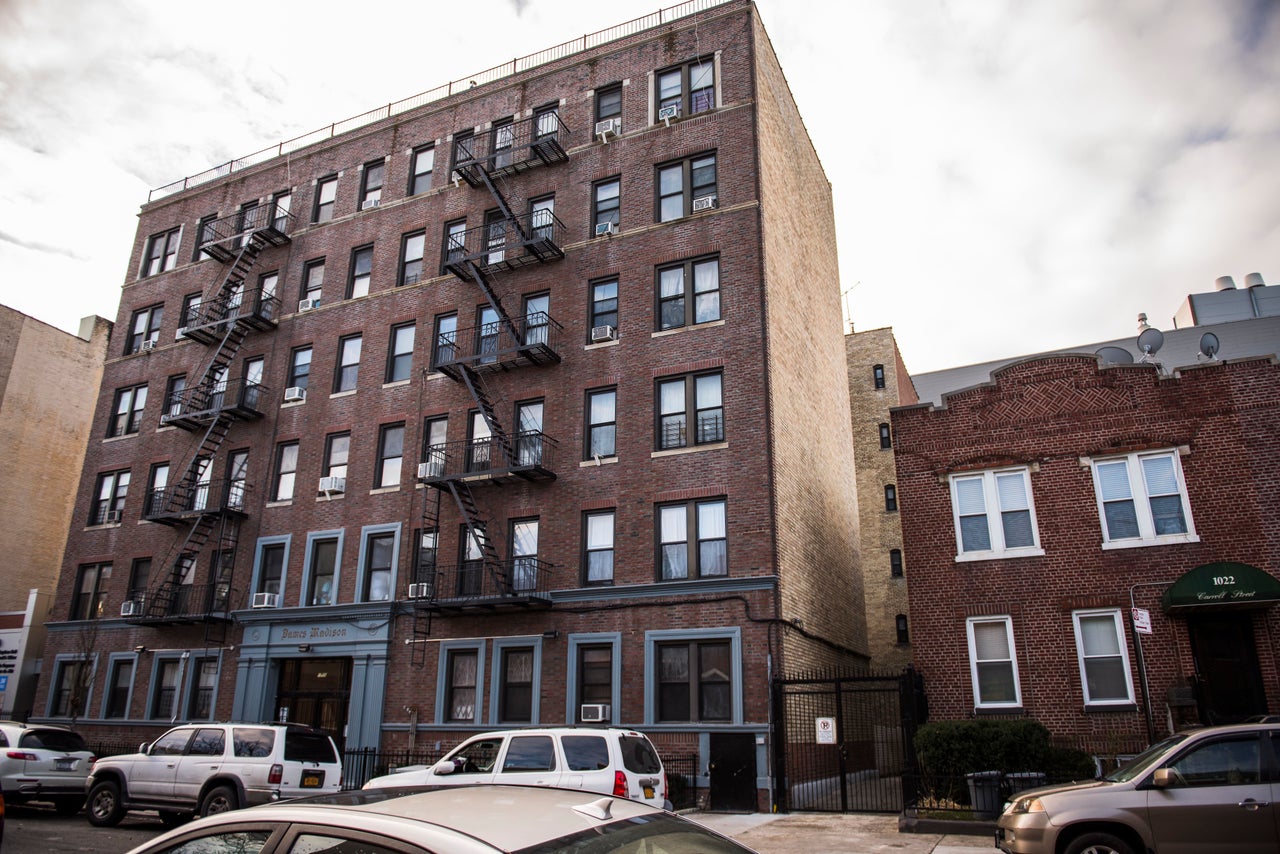
For longtime residents threatened by gentrification, staying in a healthy neighborhood is particularly difficult when trying to fend off a landlord who wants them out.
According to public documents, the owner of 1030 Carroll Street, Ephraim Fruchthandler, bought the building in 2014. Since then, according to architectural plans, as well as multiple visits to the building between October and February, Fruchthandler has been subdividing and renovating the building’s unoccupied units. Then he rents them out at market rate to young professionals, for more than two times what rent-stabilized tenants like Fenner pay for their two-bedroom apartments, according to rental prices advertised on the real estate website StreetEasy.
He’s far from alone, many landlords in gentrifying neighborhoods from Chicago to Los Angeles do the same thing.
Multiple efforts to reach Fruchthandler were unsuccessful, and his office declined numerous requests to comment for this story, but an employee who answered the phone at his offices confirmed that he owned the building.
Fenner can’t afford to leave her rent-stabilized unit, even though she is concerned about her health. If she moved, she said she’d have to leave New York entirely. And although she’s staying put, several of her neighbors who have lived in the building for decades have already departed.
Chasing A Hidden Health Metric
Part of the reason health-focused gentrification research gets short shrift is because it’s difficult to study. Unlike crime or housing research, health data is protected by HIPAA laws, which safeguard Americans by keeping their medical records private, but simultaneously prevent researchers from doing the kind of granular investigations they undertake in other subject areas. Further complicating the matter is that people ― unlike apartments or economies ― physically move, meaning researchers don’t have the luxury of studying change over time unless they hunt down study subjects on an individual basis.
In a recent PubMed database search for gentrification and health studies, more than half of the 43 study results yielded were published in the last three years. The oldest dated back to 2007. A comparable search for gentrification and housing studies on the National Bureau of Economic Research’s database yielded 13,970 results.
This research is challenging, but there are some clever ways of getting around HIPAA. One researcher, Jackelyn Hwang of Stanford University, used credit score data to track residents’ moves out of Philadelphia neighborhoods.
Similar to other structural factors like wealth, education and access to medical care, all of which can boost or diminish health and well-being, neighborhood quality plays an outsized role in residents’ lives and health outcomes.
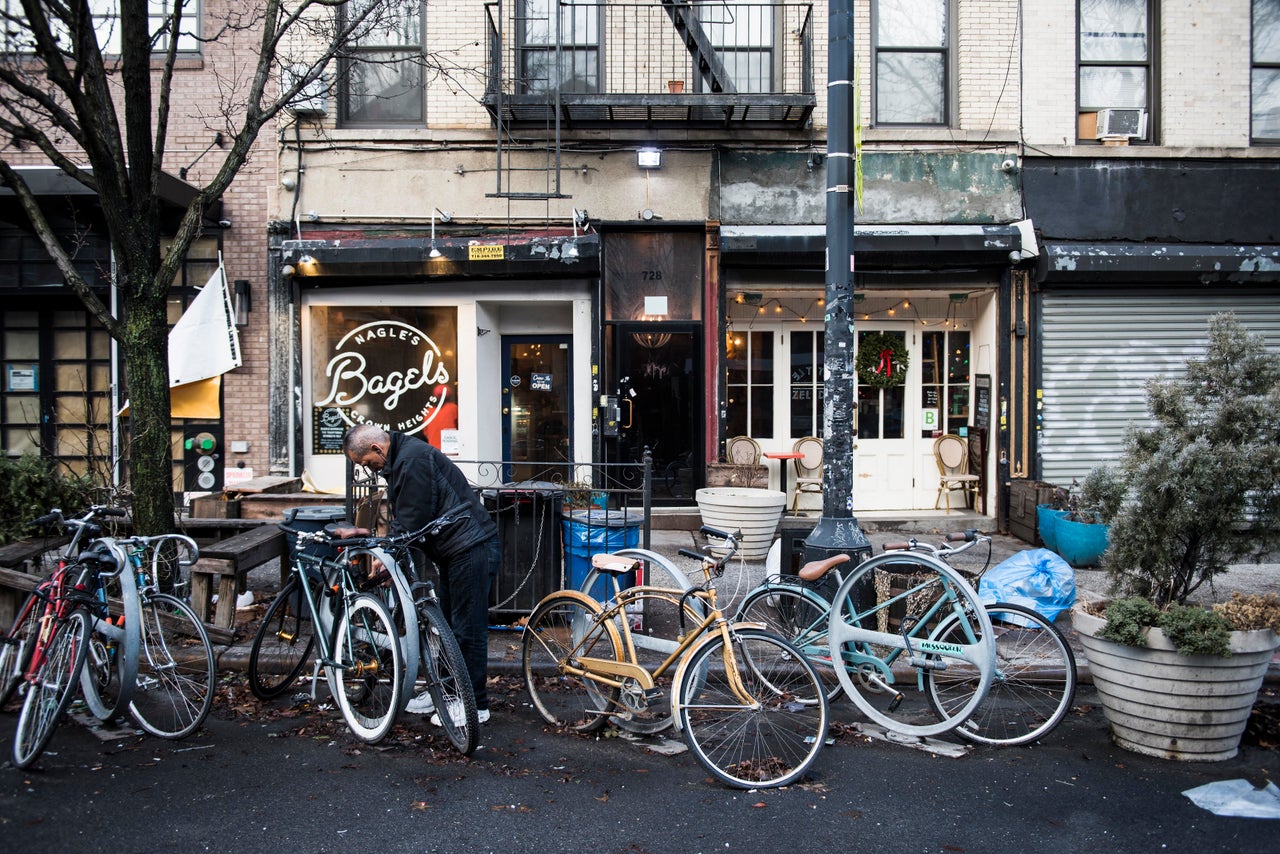
New York City has grappled with the consequences of gentrification longer than most other American cities, according to Karen Chapple, a professor of city and regional planning at the University of California, Berkeley, who worked under New York City Mayor David Dinkins in the late 1980s and early 1990s.
Starting in 1969, the city reacted to housing crisis pressures by passing strong rent control and rent stabilization laws.
“That has played a powerful role in keeping the core of the city diverse,” Chapple said.
Rent regulation, which limits how much landlords can charge tenants, is a protection that has kept hundreds of thousands of New Yorkers affordably housed. In 2017, there were 840,000 rent-stabilized apartment units in New York City, according to New York City’s Division of Housing and Community Renewal.
By contrast, Chicago, which similarly has valuable housing and a significant number of low-income residents, saw its affordable housing stock legislated away in the 1990s.
Almost half of Chicago residents say they are rent burdened ― spending more than 30 percent of their income on housing ― compared to 31 percent of Americans who are rent burdened overall, according to a 2016 MacArthur survey.
Eviction is an ongoing problem in Chicago, where in 2016, the Circuit Court of Cook County received 24,000 Chicago eviction filings, the majority of which were landlords trying to evict their tenants. Rent regulation in Chicago ― as well as the rest of Illinois ― is illegal, and landlords in effect can evict tenants at their discretion, without being required to explain their reasoning for terminating a lease. And while the number of eviction filings in Chicago has dipped since 2006, experts say that’s not necessarily a sign that the city’s renters are staying housed.
The city dealt low-income Chicagoans another blow when it demolished the notorious Cabrini-Green housing project in the 1990s, which had been home to nearly 15,000 families.
Instead, in the face of rising rents, and with few tenant protections, struggling Chicagoans may be leaving the city altogether. Indeed, the populations of the poorest neighborhoods in Chicago, on the city’s south and west sides, fell by a combined 50,000 residents between 2010 and 2015, according to census data analyzed by Crain’s.
Another factor that stacks the deck against Chicago renters is the city’s lack of a just cause eviction ordinance that other big cities like New York, Boston and Seattle have, which prevents landlords from arbitrarily evicting tenants. To evict someone in New York City, a landlord must cite one of the city’s specified tenant violations as grounds for eviction, such as failure to pay rent.
From an educational standpoint, there are active and progressive public discussions in Chicago about gentrification and health, like the one Gurin-Sands participated in. In that regard, advocates and residents have a lot of optimism, but when it comes to policy, the city is still playing catch up to New York City.
Still, despite New York’s relatively stronger protections than a city like Chicago, it’s protective rent regulations nonetheless risk being eroded in the face of a booming real estate market. Landlords who own rent-regulated properties spruce up apartment units to attract higher-paying tenants. If they upgrade the unit enough, they can rent it at market rate and make more money. They just have to convince their rent-regulated tenants to leave first.
‘Turn On The Heat On Carroll Street’
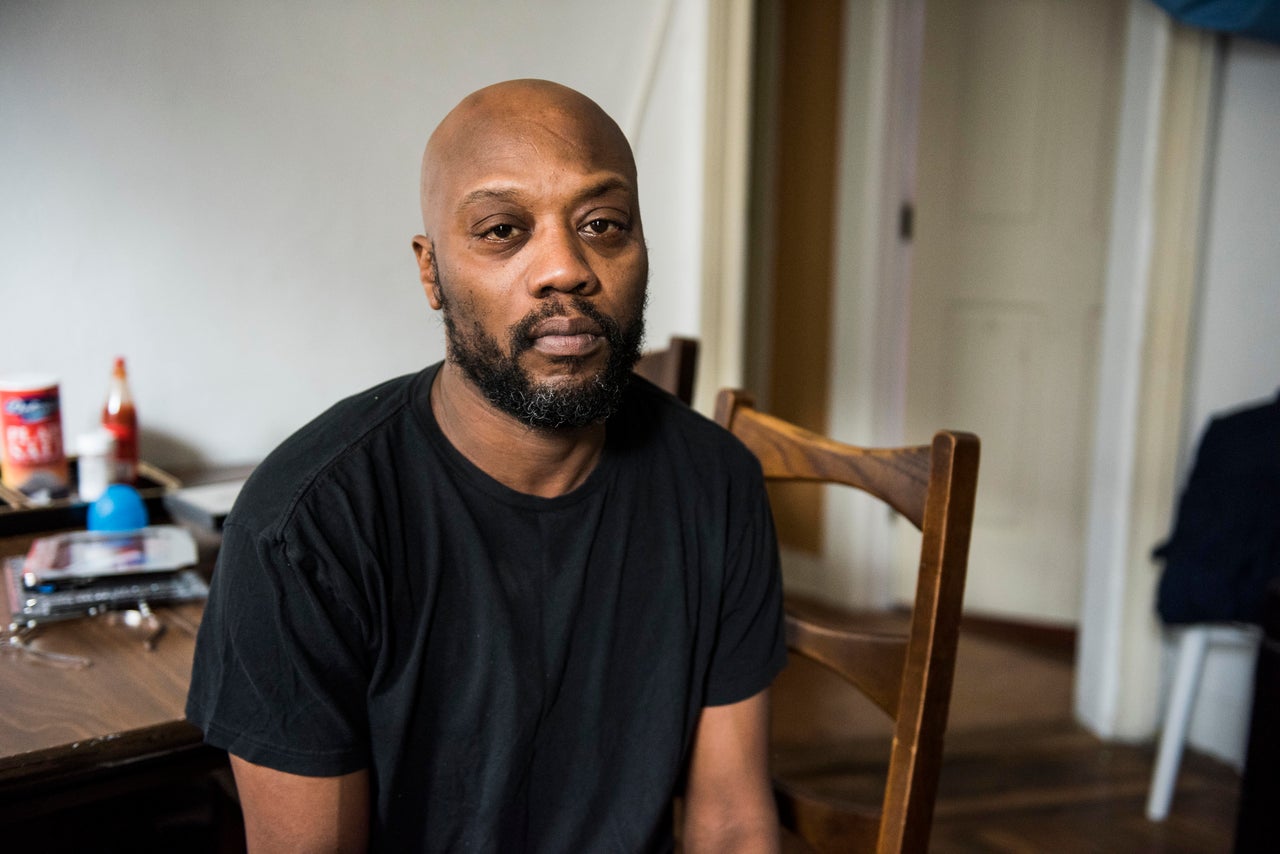
Between October and February, tenants at 1030 Carroll street logged nearly 200 complaints about lack of heat in their building, according to Department of Housing Preservation & Development records. In December, they organized an action to protest their lack of heat and hot water in their building, during which tenants, housing organizers and local officials gave megaphone speeches criticizing Fruchthandler and the building’s living conditions. During the protest, an art collective projected slogans like “Heat For The Holidays,” “Baby, It’s Cold Inside” and “Turn On The Heat On Carroll Street,” along with Fruchthandler’s phone number, on the side of the building.
“He has harassed long-term tenants with constant construction that has resulted in frequent debris and pest problems, and has refused to provide basic services like heat and hot water,” said Letitia James, the city’s public advocate, who spoke at the December action and has supported the 1030 tenants in their battle for healthy living conditions since early 2016.
In addition to the heat and hot water complaints, the 1030 Carroll has 74 open violations for offenses such as leaking ceilings, defective smoke and carbon monoxide detectors and peeling lead-based paint. John Sykes and his 16- and 5-year-old daughters live in the fourth floor unit with the overdue lead paint violation.
“The city came in and actually fixed them,” Sykes said of the lead violations, noting that he didn’t blame the landlord for the fact that the prewar building had lead paint in it. “But the same way they are fixing up the new apartments, they could fix up the old ones,” he said.
Lead exposure is harmful at any age, but it’s especially dangerous for kids younger than 6, whose brains are still developing. A child exposed to lead may look healthy, but health problems linked to lead exposure, like brain damage, hearing problems, kidney dysfunction, anemia, headaches, reduced IQ, behavioral issues and seizures, can kick in 5, 10 or 15 years in the future.
“People don’t know to call 311 and ask them to check for lead,” said Sykes, 40, who works for a building management company.
“You have to actually call and request it. It’s not [the city or the landlord that] says, there’s a kid under 6, we should inspect. The only way they go about it is if a parent complains.”
When Gentrification Means An Uptick In Hospital Visits
Being poor is bad for your health, and so is living in a disadvantaged part of town. Babies born in poor neighborhoods are more likely to be exposed to environmental hazards, like lead, mold and rodents, which can lead to chronic disease, learning disabilities and injuries.
Residents in such areas are more likely to be exposed to violence, including gun violence and domestic abuse, which affects life expectancy or can lead to post-traumatic stress disorder.
But being poor in a rapidly gentrifying neighborhood, or being priced out of such a neighborhood and moving into a poorer one, has its own unique health challenges.
Crown Heights ranks among the fastest changing neighborhoods in New York City. It’s one of eight neighborhoods there that researchers at the city’s Department of Health and Mental Hygiene identified as undergoing a rapid increase in median household income and rent prices, coupled with a spike in residents with college degrees, between 2005 and 2014.
These researchers found that New Yorkers who moved from gentrifying neighborhoods to non-gentrifying, poor neighborhoods, had a bigger rise in hospital visits in the five years after their displacement. Hospital visits among residents who were displaced rose 63.9 percent between 2006 and 2014, compared to 18.7 percent among residents who stayed put.
But the researchers also found that the health impact of gentrification fell heavily on those who managed to stay in their neighborhoods, who saw a parallel, but smaller uptick in ER visits.
The biggest spike in ER visits among displaced residents took place in gentrifying North Brooklyn neighborhoods like Williamsburg and Bushwick, as well as in Manhattan’s Chinatown and Lower East Side.
“Displacement from gentrifying neighborhoods was linked with increased emergency department visits or hospitalizations, in particular due to mental illness,” Lim, the department researcher, explained.
Emergency room visits among displaced residents from Crown Heights, where Fenner lives, shot up more than 60 percent between 2006 and 2014, compared to about a 19 percent increase among residents who stayed in the neighborhood. And across New York City, there’s evidence that displaced residents experience disruptions in their health care access and increased hospitalizations and emergency department visits for mental health.
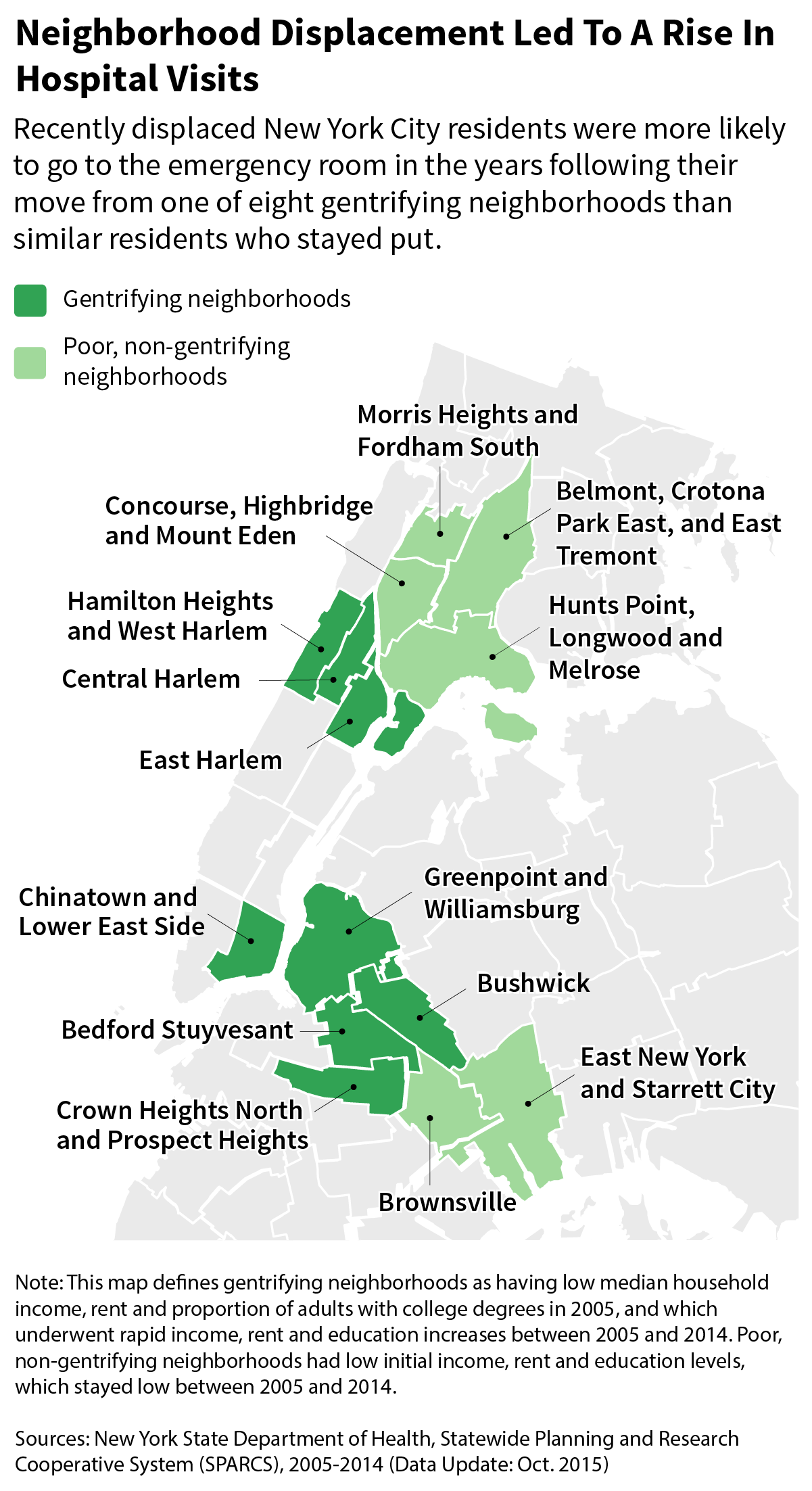
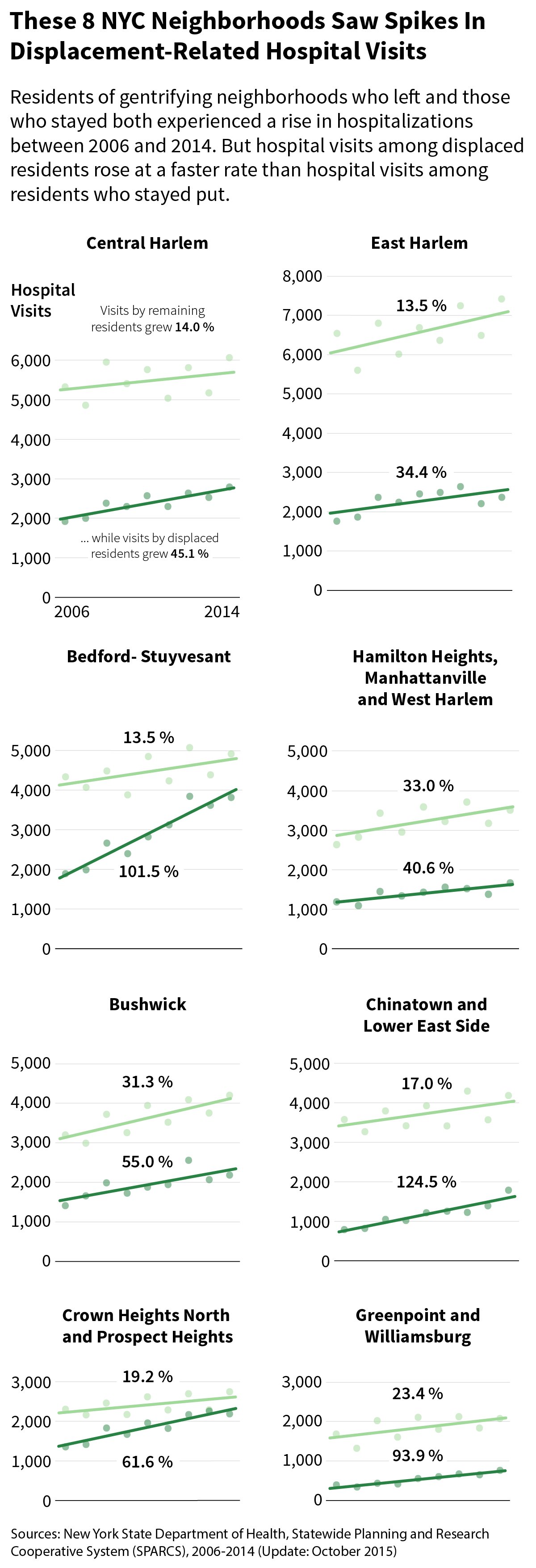
Ingrid Gould Ellen, the director of the urban planning program at NYU Wagner and a faculty director at the Furman Center for Real Estate and Urban Policy, cautioned against overstating the New York City health department’s findings.
“Everyone in their study is ‘treated’ by gentrification,” said Ellen, who has more than two decades of experience in the field but wasn’t affiliated with the department research. “They focus on comparing outcomes for people who are able to stay in gentrifying neighborhoods with outcomes for those who leave. As [the researchers] acknowledge, they don’t know why some people leave and some people are able to stay in those neighborhoods.”
Like any single study, the new research is better viewed as a foundation for the gentrification and health literature that will be written as the field grows. And although the health department researchers couldn’t prove that gentrification caused displacement in their work, Lim hopes that future researchers will be able prove that link, as well as explain why certain gentrifying neighbors saw bigger hospital visit spikes than others, which his research didn’t explore.
In Housing Court, A David And Goliath Face-Off
New Yorkers who don’t live in rent regulated buildings, or even worse, don’t have leases at all, are beholden to the whims of their landlords, some of whom see a booming real estate market as an excuse to evict existing tenants, raise the rent and turn a bigger profit.
Unexpectedly losing housing is tumultuous for anyone. For a senior citizen on a fixed income or someone who is already combating illness, an eviction can be devastating.
For more than three decades, John Smith, 72, has lived in an apartment in the increasingly gentrified Flatbush neighborhood of Brooklyn, about 2 miles south of the Carroll Street building. When the lease holder, his roommate Steven Guitano, moved out, Smith continued paying the rent each month, but he was never on the official lease. Because he and Guitano weren’t related, and he couldn’t get in touch with his former roommate after he left, Smith didn’t have much legal recourse when his landlord served him an eviction notice in 2013, according to public records.
Smith went to housing court without legal representation, while his landlord brought multiple lawyers. Smith said they badgered him outside of the courtroom, telling him he didn’t have any right to stay in his apartment.
“Your rent is cheap,” Smith said a lawyer told him, adding, “They paid a lot of money for the building.”
A representative at Brooklyn Equities 11 LLC confirmed to HuffPost that the management company owns Smith’s building, then hung up. The company did not return subsequent phone calls and voicemails. The law firm that represented the management company in the eviction proceedings declined to comment.
“It was hard. I had prostate cancer and I was being evicted,” Smith said. He said he was going to court for years. “All this is in your mind. You’re trying to deal with your cancer, plus your other problems. I think it could do something physically and mentally to you at the same time.”
In 2013, a year before city council members introduced a bill to establish a tenants’ right to counsel, 99 percent of tenants went to housing court without a lawyer. Today, 73 percent of tenants are unrepresented. In comparison, almost every landlord brings a lawyer to court, according to the city’s Office of Civil Justice. Last summer, New York City Mayor Bill de Blasio signed the council bill into law, thus guaranteeing full legal representation to any low-income New Yorker facing eviction, though the policy will take five years to phase in.
While a judge extended Smith’s eviction date several times, he was ultimately forced to vacate his two-bedroom, $987 apartment for good last spring and rented a room in Harlem, where he now lives with strangers.
Smith’s new apartment is closer to Harlem Hospital, where he receives regular prostate cancer treatments, and where he stayed overnight after having surgery on a hernia last year.
But he said the years he spent battling eviction were constant stressors in his life.
“I get a little stressed,” Smith said before his eviction. “I’m not suicidal or nothing like that, but stupid things be pushing in.”
The Ties That Bind ― And Break
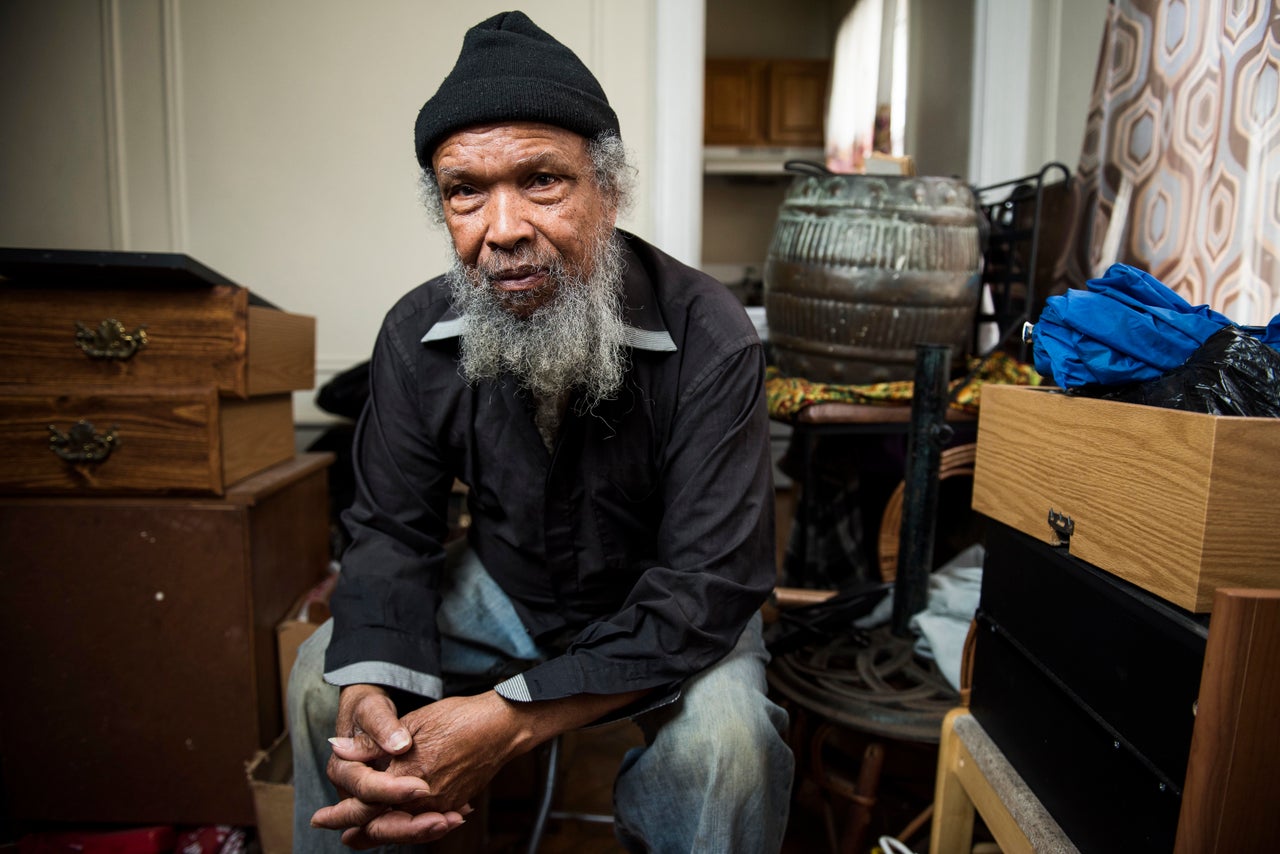
Winston and Violet Stiell spent three decades in the same apartment, working in a storefront below the unit, in Prospect Lefferts Gardens, another gentrifying Brooklyn neighborhood. About a year ago they were evicted and after 60 years of living in New York, Violet fled the city.
“I had a meltdown,” she explained from her new home in a senior living facility in Baltimore, Maryland.
Winston, a craftsman and appliance repairman, moved to East Flatbush, but said he has been “dead broke.” He sold his brightly painted van for less than two hundred dollars. Now he walks everywhere or takes the bus.
The Stiells have long-standing health issues that weren’t caused by gentrification, but the rising cost of living in their gentrifying neighborhood didn’t help.
“If you don’t have your other needs met, it’s a lot harder to keep up with your health,” Gurin-Sands said about the kind of predicament the couple has found themselves in.
Winston said he was diagnosed with diabetes six or seven years ago, and although he has a bad back, which makes bending over difficult, he hasn’t seen a doctor in years. Instead, to ward off anxiety, he carves cow horns into the shape of birds and sells them. But his new apartment doesn’t get the foot traffic that his old studio and workspace in Prospect Lefferts Gardens used to garner, and he’s not selling very many horns these days.
He went to housing court to fight their eviction, but since Winston had a word-of-mouth agreement from his landlord, he couldn’t rally much of a defense. Like Smith, Wintston’s landlord brought a lawyer to court. Stiell represented himself.
“The property was facing foreclosure partly due to Mr. Stiell failing to make rent payments for over two years,” said Jeffrey Homapour, the attorney who represented Stiell’s landlord in housing court. Winston, 75, said he didn’t remember it that way, and that he’d only withheld rent for two or three months.
“Despite the expiration of his lease term and his obligation to vacate the commercial store and apartment, Mr. Stiell refused and dragged out the court process for over six months failing to comply with his court-ordered obligations and ultimately vacating by his own volition,” Homapour said, adding that Stiell had every opportunity to be represented by counsel of his choosing.
“I went to Legal Aid, but they didn’t want to take my case,” Winston said.
“I never got involved with all that stuff,” Violet said. “I have panic attacks. I’m brave, but at a certain point I get terrified.”
The landlord has since renovated the Stiells’ former apartment. When Winston lived there, he said he paid $600 for his non-rent stabilized apartment and $800 for his shop each month. According to rental prices advertised on the realty website Naked Apartments, a one-bedroom apartment in his former building currently rents for $1,800 per month.
“The bottom line is money,” Winston said.
He can’t pay the rent at his current place without subletting his second bedroom. This is keeping his wife from returning ― she isn’t interested in moving in with roommates.
“Everybody saying she’s not coming back,” he said. “It seems like I’m the only one who doesn’t know that yet.”
Marriage, arguably the strongest social bond of all, helps to safeguard health, especially for married men, who have more heart health protection, a reduced Alzheimer’s disease risk and better mental health than their unmarried counterparts.
“Displaced persons no longer have access to the same social networks, may lose community ties, and suffer disruptions in regular routines, which increase stress and psychological distress,” the health department researchers wrote in their paper.
A Fight To Stay In The Neighborhood School
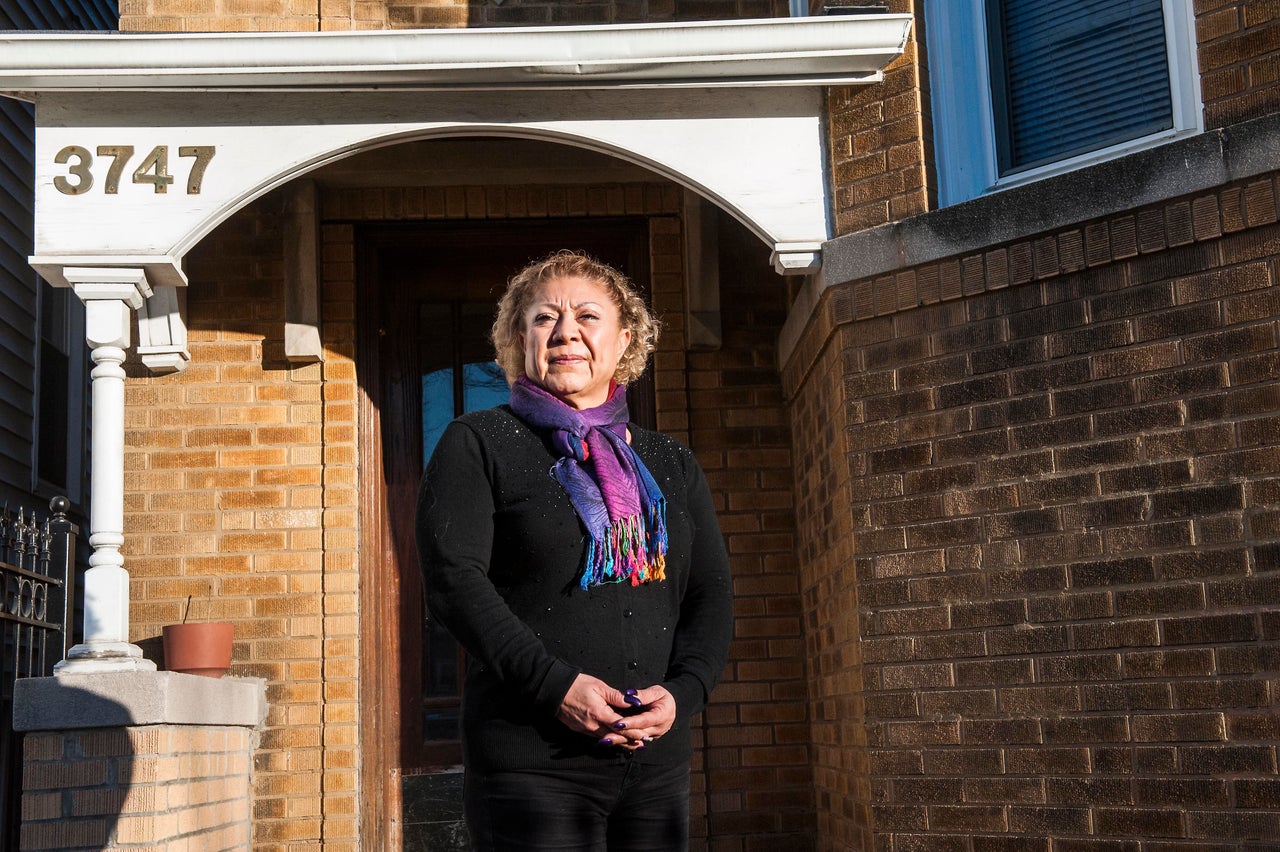
If Leticia Trigsted is evicted from her apartment in April, the eviction will be her sixth since 2002, according to public records.
Over two years ago, the 52-year-old moved into her apartment in Irving Park, a gentrifying neighborhood of low-slung, pre-war bungalows on the Northwest side of Chicago, many of which feature wide front lawns.
Trigsted could barely afford housing prices in the area, but felt compelled to stay in the neighborhood she’s lived in for the last decade because of her daughter. Irving Park is safe and clean, with a large Hispanic population and more affordable rent than the city’s lakeside neighborhoods. It’s also close to her teenage daughter’s school. “This is my home,” Trigsted said.
The apartment she found needed some work, but the husband and wife owners promised to fix it up.
Trigsted and her partner did their best to make the apartment livable. They bought a new refrigerator and microwave for their unit and cleaned up the three-story building’s common areas by removing leaves from the backyard and vacuuming the communal stairs. Then last summer, a few months after Trigsted moved in, a crack started on her bathroom ceiling and spread across the room. When her upstairs neighbor washed dishes or used the toilet, water would leak into Trigsted’s kitchen and bathroom.
“Water was running through the cabinets,” she said. Trigsted had placed a bucket next to her stove to catch any errant drips from above. On top of her refrigerator was a jar full of dead flies she’d trapped, an insect infestation she attributed to the ongoing kitchen leak.
When Trigsted’s daughter comes home from school these days, she stays in her room to avoid the smell they attribute to the leak. Standing water such as Trigsted’s leak bucket can quickly become breeding ground for disease-spreading mosquitoes, and for mold, which releases spores into the air that can aggravate respiratory problems.
When the landlord didn’t fix the leak, Trigsted starting calling 311 to report her living conditions, placing three calls to the city in total. Then, in November, Trigsted’s landlord served her a 30-day eviction notice. Trigsted thinks her eviction was retaliation for the 311 calls.
“It doesn’t seem fair. We have to move and he gave us 30 days notice,” Trigsted said. “Why? [The wife] just said that this is her building and she wants me out.”
Luis Molina, Trigsted’s landlord, said her eviction wasn’t related to Trigsted’s calls at all. “I was trying to redo the whole building,” he said. The building is 100 years old and needs plumbing and electrical work done, he stressed, noting that the other tenants are leaving, too.
Molina said that Trigsted was a model tenant. She was clean and paid her rent on time. But Molina was frustrated that Trigsted was fighting her eviction, with help of a Chicago-based tenant collective and an attorney. “She’s being totally unfair,” he said.
In the end, Molina extended Trigsted and her family’s move-out date to the end of April. She won’t have to pay rent during that time. “I’m sure she’s saving [for a new apartment],” Molina said. But after accounting for moving expenses and rising rents in the neighborhood, the money Trigsted will save isn’t likely to go far.
Trigsted looked at an apartment a street away from her current home, but the rent was $1,400 a month, compared to the $1,050 she pays now. In addition to higher rent, the new apartment charges a $300 per month pet fee for every animal that lives on the premises, meaning Trigsted would be paying $600 per month above her base rent if she wants to keep her dog and cat.
“That’s way too much,” said Trigsted, who works in the produce section at a local grocery store. Instead she hopes her son will cosign on a house with her this year. She just has to pay down her credit cards first, she said.
Racial Profiling Fears May Hurt Health

For other long-term residents of gentrifying neighborhoods, gentrification-related stress isn’t about money at all.
Sinaka Garcia, 42, was born in Caledonian Hospital, known today as The Parkside Brooklyn, a luxury building overlooking the southern end of Prospect Park in the Flatbush neighborhood.
Garcia owns a small welding and fabrication business, making custom exhaust systems for high-end cars. He’s also a “black and Hispanic man in Brooklyn,” as he puts it. “Unfortunately, that’s a strike,” he said. “I always feel targeted.”
Despite the fact that crime in his neighborhood, as well as in the city at large, has plummeted since Garcia was a teenager in the 1990s, he said the number of police officers he sees patrolling the neighborhood has ballooned.
As a person of color, he’s apprehensive to get behind the wheel of the high-end cars he works on in the face of increased police presence.
“If a cop gets behind me, or I see a cop on every corner, I’m scared I’m going to get pulled over,” he said. “It’s a terrifying feeling.”
And while on its face, racism might not seem like a health problem, studies show that discrimination can trigger elevated stress hormones. Over time, that chronic stress can manifest itself as various health problems, including an increased risk for conditions like heart disease and diabetes.
In fact, there’s some evidence to support that even the expectation of a racist encounter, similar to the spike of fear Garcia described while driving, can cause stress hormones to soar.
Garcia also stressed the complexity of neighborhood change ― as a pescatarian of two decades, he said he was happy to have health stores replacing fast food chains. But unlike Garcia, who used to leave the neighborhood to buy healthier food, his neighbors aren’t going to patronize Flatbush’s expensive new restaurants and bars, he explained.
In other words, while in theory an organic corner store might seem to help the neighborhood at large, if only newcomers shop there it primarily benefits a fraction of that neighborhood. And as boutique coffee shops and organic corner stores replace affordable supermarkets and laundromats, longtime residents see their neighborhood options shrink.
Garcia lamented the neighborhood’s lack of nutrition education, explaining why residents should pony up for healthier foods at higher prices.
“The government knows when a neighborhood is being gentrified. But instead of putting programs in place, they just come in bulldozing,” he said.
The Grinding Toll Of Landlord Pressure

Displacement isn’t solely the result of evictions and intolerable living conditions. Despite the health risks, for many New Yorkers in gentrifying neighborhoods, landlord pressure to leave is ultimately too exhausting to ward off indefinitely.
“It rises to the level where you can haul them into housing court, but [the landlord] can get an attorney and make all kinds of excuses and he’ll get more time,” said James, the public advocate. “In the meantime, you get frustrated and he offers you $20,000 to leave and you get so frustrated you take it.”
“Each time [the city housing agency] comes by, they give this owner a pass,” complained Fenner, of 1030 Carroll Street.
That’s partially because the lack of heat and disruptive construction are considered middle-grade offenses by the city.
When asked why the violations at 1030 Carroll hadn’t been fixed, despite her advocating for the building for two years, James said that while important, they weren’t “serious enough.”
“Obviously everything is relative,” she said. “They are not life-threatening. They are issues that affect your quality of life, that ultimately affects your life.”
On a crisp February afternoon, Ari Weber showed HuffPost’s reporter around the unit adjacent to Fenner’s apartment. Weber is the CEO of Brookliv, one of several realty companies that serve as a middleman between Fruchthandler, the landlord, and prospective renters for the renovated 1030 Carroll apartment units. He’d never met Fruchthandler personally, one of the more than 300 landlords he works with in the city. Weber said he didn’t know anything about the circumstances of the existing 1030 Carroll tenants.
Weber made headlines last month when he started accepting Bitcoin as a payment option for his Brooklyn rentals, and in the six weeks since then, he said he’s had three prospective tenants who are interested in paying their rent in cryptocurrency.
The first floor hallway of 1030 Carroll had been touched up with fresh paint and the high-shine wood floors gleamed as we entered the renovated unit. As we admired the new luxury fixtures, like a stacked washer and dryer, and private outside space, Weber described the demographics of the tenants he expects will rent the new luxury units. “People like you,” he said, before describing white professionals between the ages of 25 and 34, who want to move to Brooklyn from Manhattan.
When prospective renters go to view Weber’s buildings, they never ask about gentrification directly. Instead they say, “How’s the neighborhood?” by which they mean, “Is it safe?” Weber explained.
“I tell them it’s safe before the words even come out of their mouth.”
Weber grew up in New York and now lives in the Sunset Park neighborhood of Brooklyn. His office sits just across Franklin Avenue from 1030 Carroll Street, and he said the change he’s seen over the last two-and-a-half years in the neighborhood has been dramatic, with a stream of commuters every morning up Franklin Avenue, catching the train into Manhattan for work.
And although Weber is making a name for himself in real estate, it’s not a family business. His own father faced eviction proceedings, before ultimately dropping the case and moving to New Jersey. Despite that personal connection to eviction, however, Weber thinks housing court is unfairly weighted in favor of New York City tenants, who can draw out eviction cases for months because of New York City’s tenant protections.
James, the public advocate, sees the equation differently. “Human and civil rights take a priority over property rights,” she said.
“When you are harming someone, when you are putting their health and their safety in jeopardy, that should trump property rights.”
Additional reporting by Sebastian Murdock.
This story produced as a project for the University of Southern California Center for Health Journalism’s National Fellowship.
